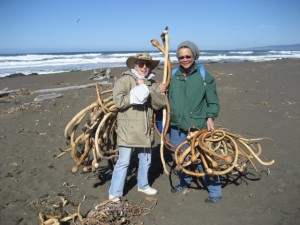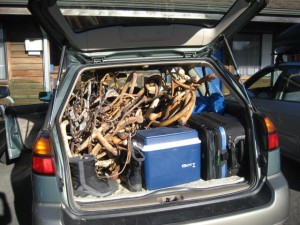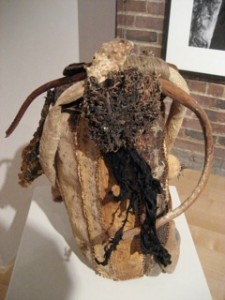The minute Gail Ruvalcaba first touched wet bull kelp, she knew she would love to work with it. As a ceramicist and sculptor, she found the slimy, wet kelp just as malleable as clay, and there were endless things that could be done with it. It could be plaited, coiled, & twined, used for knotless netting or random weaves. She soon found that strips of it could be laid out & cut according to design patterns, and then sewn & embroidered to create patchwork baskets with the strength and feel of bark. The kelp could be further shaped by stuffing the finished form with newspaper, and then embellished with other seaweeds, driftwood, and just about anything else. Moreover, it was practically free (except for the required state license for kelp collecting professionals) and economical to use as no expensive tools are required. Different parts of the bull kelp whips lend themselves to particular techniques and final forms; stipes—the long thin parts of the tail–are best used for netting and weaving, while the thicker ends work well for plaiting. Kelp heads are incredibly evocative, fabulous for decoration, and can be turned inside out for smooth round forms.

Cylinder from the Sea
Gail has been creating with kelp for some 20 years now. While a background in art (B.A., Chatham college) provided fundamentals in composition and design, it’s her more recent three dimensional work, first in ceramics and now in kelp, that really excites her. Her kelp creations have been exhibited in numerous California galleries and exhibits, earning a basketful of prizes, including CNCH merit awards.
Gail finds that foraging for seaweed is always an adventure. As she advises, “you may not come home with what you wanted, but you always come home with something that then may lead to a new invention.” The element of surprise is always part of her foraging expeditions: no matter how many times she has found a certain kind of kelp at a particular beach, there’s no assurance that it will be there on the next trip. Like the polished abalone shell pieces, used for decoration, or the driftwood for embellishment and handles, the flotsam and jetsam of the ocean depends on storms, tides and multiple natural factors for shore delivery.

'Sewn Cylinder' was two feet tall when wet; now dry, it stands only 6 inches.
So what is kelp? As Gail says, “it’s just the ocean’s algae.” There are two canopy forming brown macroalgae species on the California coast: giant kelp (Macrocystis pyrifera) in southern California, and bull kelp (Nereocystis leutkeana) from Monterey Bay north. Gail primarily uses bull kelp, an annual seaweed that can grow up to 2 feet a day, with tails or “stipes” reaching to 130 feet! It grows along the rocky coastline anchored to the rocky substrate by “feet” called holdfasts. From the holdfasts, kelp plants grow up to the surface of the ocean, buoyed by gas bladders that keep the upper portions of the algae afloat. The kelp we collect on the beach has lost its moorings, and has floated in on the tide.
Gail warns that California kelp foragers need to know some basic rules. There’s no collecting permitted in marine life refuges, marine preserves, ecological reserves, national parks or state underwater parks. Collecting or disturbing of sea palm (Postelsica), a very short look-alike relative of bull & giant kelp, is prohibited everywhere. Ten pounds of wet kelp may be collected daily for personal use, but if you sell kelp or kelp products, you must have a Kelp Harvesters License.

Gail and Lorrainne Oller collecting Kelp
Gail collects only sun-dried kelp. The green, wet kelp that you often find on the beach is too thick to weave, too heavy to carry the inevitable long distance back to the parking lot—and you’ll end up with a car full of sand flies and a pungent & long-lasting odor. As she drags her red sled filled with kelp along the sand, she is inevitably besieged by curious beachgoers with many questions—and good consequences. Friendly offers have included invitations to birthday cake, champagne, and most importantly, assistance back up beach cliffs to the parking lot.
Once back home, Gail stores the kelp in a dry environment; when she is ready to use it, she will submerge the kelp in water until it is flexible enough to weave. Be aware that a kelp basket will shrink considerably as it dries! The finished vessel should be sun-dried, or oven dried at 150 degrees with the oven door cracked. If stuffed with newspaper to hold its shape, stuffing should be changed twice daily until the basket is perfectly dry. In cold damp weather, it still may “sweat” a fine white salt, and should be rinsed and dried again quickly. Don’t leave your finished piece outside or you may find it melts down to an unintended shape!
Gail has been teaching classes in kelp basketry for many years. If interested, give her a call at (925) 846-8960.

A great haul!

'Manchester Beach II'